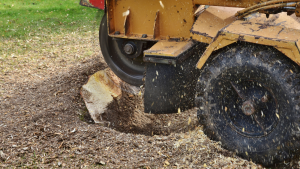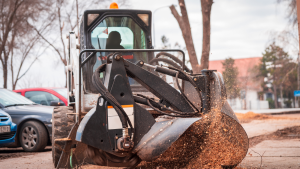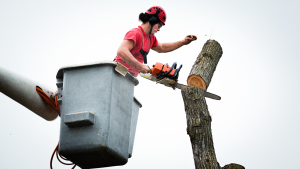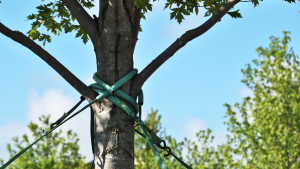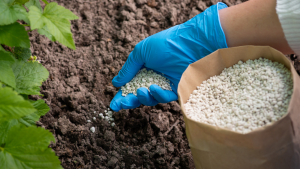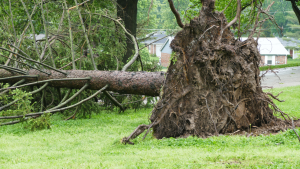The term “tree blight” describes a number of related contagious tree diseases that can affect hundreds of different native Illinois species, including fruit trees and pines. These illnesses, which can be brought on by bacteria or fungi, typically cause leaves and fruit to turn brown and wilt. Severe incidences of tree blight can result in dead branches that may even require removal.
It is typically disseminated by insects to delicate leaves and fruit, whether it was started by a fungus or a bacterial infection. It might also be spread by the wind and the rain. Once inside the tree, the bacterium or fungus travels to the vascular system where it can spread to other parts of the tree and finally the roots. A dark colored slime that is coming from infected leaves, fruit, and branches may be causing the leaves and fruit to wilt and becoming discolored. Several native Illinois trees, including fruit trees like apples, crabapples, and pears as well as pine, maple, oak, dogwood, and elm trees, are susceptible to tree blight diseases.
In this article, we’ll examine tree blight in general as well as particular diseases that might affect various kinds of trees. This covers the symptoms of tree blight, how these diseases affect trees, and how to treat and manage tree blight. Joliet Tree Service’s expert arborists can assist with effective tree care, including tree care and maintenance to prevent and treat tree blight and other tree diseases. If you think your trees may be suffering from tree blight, it’s critical to get in touch with our expert arborists at Joliet Tree Service because failing to recognize these diseases’ symptoms can cause serious harm to your trees, including their eventual removal.
The Progression of Tree Blight
The bacteria or fungus that causes tree blight illnesses frequently overwinters in the cankers, branches, or trunks of trees that are already affected. When springtime comes around, the bacterium or fungus grows in the moist environment and secretes an ooze through organic cracks in the bark. Insects are drawn to this ooze, which renders them carriers of the bacteria or fungus. These insects, which are primarily pollinators, will spread the bacterium or fungus to healthy trees’ leaves, fruit, and flowers, where it will reproduce before infecting the tree.
The major carriers of many types of tree blight are pollinating insects, although the bacteria or fungus can also be transferred by wind, rain, and even pruning if the equipment used for tree trimming is not disinfected after each use.
Particularly in damp or humid circumstances, the bacteria or fungus can swiftly infect and spread through an afflicted tree. Via cracks in the bark, the virus can penetrate the tree and cause cankers on the affected branches. These branches may develop cankers that encircle them. As a result, a dark brown or black ooze may leak from the affected branches, discoloring and wilting the leaves, flowers, or fruit. Eventually, branches as a whole can die.
The infection makes its way to the vascular system as soon as it penetrates the tree, where it can spread throughout the entire tree and reach the main trunk and root system. The entire tree may become compromised when the root system is harmed, necessitating its removal.
Signs of Tree Blight
Several types of tree blight can obstruct water movement inside the tree, causing an oozing secretion that wilts and discolors leaves, fruit, and flowers, as well as dieback of the branches. If you think your trees may be suffering from tree blight, it’s critical to look for these signs:
Infected Ooze
The bacteria that cause this oozing excrete a white or tan liquid, which can be seen coming out of the infected twigs, branches, and trunk. When the ooze is exposed to oxygen, it will change color and become darker, usually black or brown.
Wilting-Wet Blossoms
The blossoms on blossoming trees will initially appear damp before wilting. The blossoms turn brown, then black, as they shrink and droop. Throughout the growth season, the blossoms will remain affixed to the branch rather than dropping off.
Infected Fruit
Fruit from fruiting trees may be impacted, becoming brown or black and becoming completely dry. Tree disease occasionally prevents fruiting trees from producing any palatable fruit at all.
Wilted Leaves
The leaves on diseased twigs and branches will wilt, bending inward, and eventually turn grayish-green, brown, or black in hue. Tree blight is so called because the leaves frequently appear burnt and continue to grow on the tree.
Cankers
On the trunk of diseased branches, cankers—areas of dead bark—may develop. They can girdle the diseased branch and restrain its growth. They may seem brown or black in hue.
Recessed Bark
An infected tree’s bark may break and sink inward, making it simple to peel off.
Discolored Sapwood
The bacteria oozing can cause lesions in the sapwood underneath the bark, which can result in brown stains.
Common Kinds of Tree Blight
The term “tree blight” refers to a group of illnesses that affect many species of trees but have similar symptoms. The majority of tree blight types are brought on by bacteria, however some can also be brought on by fungi. The most typical varieties of tree blight include the following:
Fire Blight
A particular variety of tree blight known as “fire blight” targets fruiting trees, including pears, apples, and crabapples. The spread and signs of fire blight are comparable to those previously mentioned.
Diplodia Blight
Conifers like pine trees and evergreens are specifically harmed by the tree blight disease known as diplodia blight. The needles may turn brown as a result of this illness, and fresh shoot growth may be inhibited.
Dothistroma Blight
Another disease that affects pine trees, specifically the needles, is this one. Severe situations may lead to the tree’s demise and removal.
Anthracnose
Dogwood, oak, and sycamore trees are among the hardwood trees that are susceptible to the fungus anthracnose. Trees that are impacted may have dead or dark blotches on their leaves.
Verticillium Wilt
A kind of tree blight known as verticillium wilt affects several species of maple trees. The fungus that causes this disease can be found in the soil, and it climbs the tree to cause branch dieback and brown, wilted leaves. Frequently, affected trees need to be removed.
Dutch Elm Rot
The fungus that causes Dutch elm disease can seriously harm elm trees. The fungus causes branch dieback and leaf wilting by clogging the vascular system of infected trees and obstructing water flow.
Treatment and Control of Tree Blight
Many tree blight illnesses are incurable, but if you act quickly enough, you may be able to treat blighted trees. There is still time to preserve the tree because tree blight infections often attack the branches before they reach the trunk and root system. Call our tree care specialists at Joliet Tree Service right now to identify and treat your trees if you see any indications of tree blight.
The following advice can assist you in avoiding and managing tree blight:
Pruning Trees
The best strategy to manage tree blight is to clip the afflicted branches if you notice symptoms in your trees’ leaves, blossoms, or fruit. Quick removal of the diseased branches can save the rest of the tree and stop the disease’s spread. If you trim your own trees, be sure to cut off any infected branches and disinfect your tools with a water and bleach solution to stop the disease from spreading. Moreover, you can hire a pro to trim your trees.
Applying Fungicides
Fungicidal applications can be used to protect leaves, flowers, and fruit. The best way to apply a fungicide is with a professional.
Removing Dead Branches & Leaves
A preventative method is to remove any dead plant materials since the fungi that cause tree blight thrive there.
Watering & Fertilizing
Because the bacteria that causes tree blight quickly grows in moist environments, it’s crucial to avoid overwatering vulnerable trees. Also, you ought to refrain from using too much nitrogen-based fertilizer.
Planting Blight-Resistant Trees
Planting species resistant to tree blight, such as Japanese maples and magnolia trees, is the best way to prevent it.
Tree Maintenance and Care by Joliet Tree Service
All types of tree blight can cause considerable harm to your trees, and if they are not controlled, they might even force you to remove a tree. If you suspect that your trees are suffering from a type of tree blight, it’s crucial to act right away.
All varieties of tree blight can be efficiently diagnosed and treated by our skilled arborists at Joliet Tree Service. You may rely on our experts to perform tree trimming to remove infected branches, and if we think it would help safeguard your trees, we can also apply fungicide.

